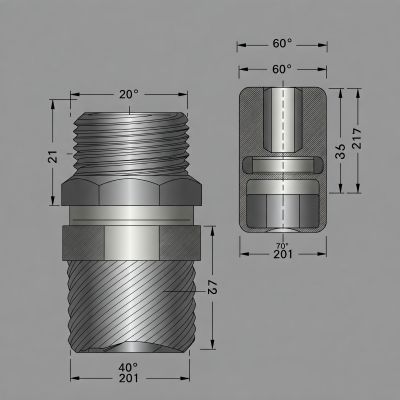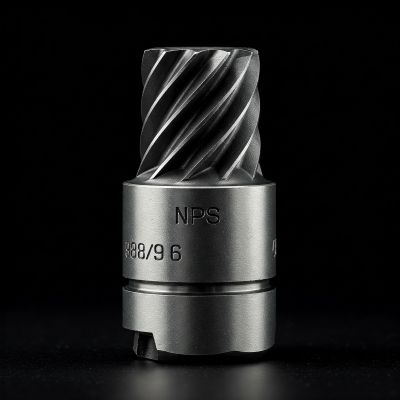In plumbing and industrial applications, pipe threads play a critical role in connecting various components like pipes, fittings, and valves. Whether you’re working on a water line, gas system, or hydraulic setup, thread compatibility is crucial to ensure a secure and leak-free connection.
Knowing the differences between thread types—especially NPT (National Pipe Tapered) and NPS (National Pipe Straight)—can help avoid system failures, leaks, or costly repairs. So let’s tackle the question that often confuses professionals and DIYers alike:
Are NPT and NPS threads compatible or not?
What Are NPT Threads?
NPT stands for National Pipe Tapered, a U.S. standard for tapered threads used to create a pressure-tight seal.
Key Characteristics:
➡️ Threads are tapered—meaning the thread diameter decreases slightly from the end toward the base.
➡️ This taper allows the threads to compress and form a tight mechanical seal as they are tightened.
Common Uses:
➡️ High-pressure applications such as gas lines, water systems, and hydraulic fittings.
➡️ Widely used in plumbing, industrial equipment, and oil & gas industries.
Sealing Method:
➡️ NPT threads require a thread sealant such as Teflon tape or pipe dope to fill minor gaps and ensure a leak-free seal.
What Are NPS Threads?
NPS stands for National Pipe Straight, another U.S. standard but with straight (non-tapered) threads.
Key Characteristics:
➡️ The thread diameter remains constant along the length of the thread.
➡️ NPS threads do not create a seal on their own and depend on a different sealing method.
Common Uses:
➡️ Low-pressure systems or applications where the seal is made by a gasket or O-ring.
➡️ Common in mechanical connections and flanges.
Sealing Method:
➡️ NPS threads rely on gaskets, O-rings, or sealing faces for leak prevention—not on the threads themselves.
Key Differences Between NPT and NPS
|
Feature |
NPT (Tapered) |
NPS (Straight) |
|
Thread Design |
Tapered |
Straight |
|
Sealing Method |
Threads + sealant |
Gasket or O-ring |
|
Applications |
High-pressure, sealing required |
Low-pressure, mechanical connections |
|
Compatibility |
Self-sealing with proper sealant |
Needs external seal |
Are NPT and NPS Threads Compatible?
Generally, the answer is NO!
At first glance, NPT and NPS threads may appear similar, especially since they can share the same nominal diameter and threads per inch. However, the thread profiles and functions are fundamentally different.
➡️ Partial Thread Fit: NPT and NPS threads may physically thread into one another for a few turns, giving the illusion of compatibility.
➡️ Seal Failure Risk: Because NPS threads are straight and NPT threads are tapered, they do not form a proper seal. This leads to a high risk of leaks, poor mechanical strength, and potential system failure.
➡️ Thread Damage: Forcing them together can damage threads, making future repairs or replacements more difficult and expensive.
Exceptions and Workarounds
While you should avoid mixing NPT and NPS threads, here are a few exceptions or solutions:
➡️ Thread Adapters: Some specially designed adapters can convert NPT to NPS or vice versa.
➡️ Dual-Compatible Fittings: Rare manufacturer-specific fittings may accept both thread types, but this should be verified explicitly.
➡️ Spec Checking: Always double-check the thread specifications before installation.
➡️ Standards Compliance: Be aware that industry codes and safety regulations often prohibit mixing thread types in pressure systems.
Common Mistakes and Misconceptions
➡️ “Same Size, Must Fit”: Assuming threads with the same nominal size will always match is a common mistake.
➡️ Hand-Tight Fit is Enough: A few turns by hand may feel tight, but it doesn’t mean the connection is sealed.
➡️ Overlooking Pressure Ratings: Using NPS in a high-pressure NPT system (or vice versa) can be hazardous.
Best Practices for Pipe Thread Compatibility
✅ Always identify the thread type before installation—use thread charts or calipers.
✅ Use thread gauges to confirm taper or straight profiles.
✅ Stick to one thread standard per system to avoid confusion and compatibility issues.
✅ Check with manufacturers or a pipe thread specialist if unsure.
✅ Use proper sealants and follow torque specs where applicable.
Conclusion
To recap: NPT and NPS threads are not compatible due to their differing thread designs and sealing methods. While they may appear similar, using them interchangeably can lead to serious leaks or mechanical failure.
To ensure safety, efficiency, and durability in your systems:
➡️ Know your thread types
➡️ Use proper fittings
And when in doubt, use matching threads or a verified adapter.
Your system—and your peace of mind—will thank you.
Post time: May-07-2025



